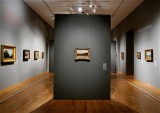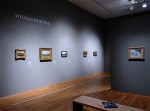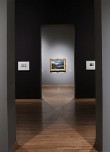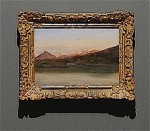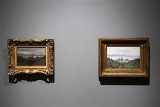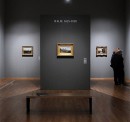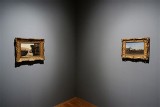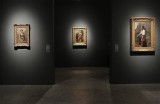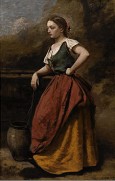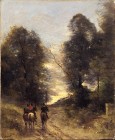The browser will either open the file, download it, or display a dialog.
Corot en Suisse
Musée Rath, Geneva
September 24, 2010 – January 9, 2011
Catalogue:
Corot en Suisse.
Edited by Paul Lang, with contributions by Paul Lang, Martin Dieterle, Vincent Pomarède, Valentina Anker, Philippe Clerc, Lukas Gloor, Caroline Guignard, Camille Jacquier, Justine Moeckli, Jean-Marie Marquis, Brigitte Monti, Marie-Therese Bätschmann.
Geneva: Somogy Editions d'Art/ Musée d'Art et d'Histoire Genève, 2010.
272 pp; 10 b/w figures and 253 color illustrations.
CHF 51: (soft cover)
ISBN 978-2-7572-286-9
When considering which major nineteenth century master had travelled to Switzerland and worked there, one might first think of Joseph Mallord William Turner. When wondering which key figure in French nineteenth century art stayed in the Alpine republic, then Gustave Courbet might first come to one's mind. Camille Corot, however, is generally not linked with Switzerland, but rather with Italy, not least thanks to Peter Galassi's excellent publication of 1992 and the 1997 exhibition, In the Light of Italy. Corot and Open-Air Painting, which was held at Washington D.C., New York, and Saint Louis, in 1996 and 1997, as well as the French-Italian cooperation Paysage d'Italie. Les peintres du plein air (1780–1830) of 2001.[1] Although the fact that the artist's mother, Marie-Françoise Corot, née Oberson, had Swiss roots, is generally dutifully mentioned, his connections with Switzerland and the many works he painted there are usually marginalized. This desideratum has now been addressed in the long awaited exhibition Corot en Suisse that was staged in Geneva as the highlight of the Musée d'Art et d'Histoire's centenary celebrations. The show assessed the artistic and social significance of Corot's many visits to Switzerland, and in addition, it unfolded the reception of the artist in that country by unifying the surprisingly rich holdings of Corot's works in Swiss public and private collections. Collecting Corot's works in Switzerland had already begun in 1859, when the artist sold his first two paintings to the canton of Geneva: Le Repos or Nymphe couchée à la campagne [Robaut 1046] and Un soir à Ville-d'Avray [Robaut 1114], both at Geneva's Musée d'Art et d'Histoire (the French state had acquired Une matinée or La danse des nymphes [Robaut 1061] only eight years earlier in 1851).
The ambitious exhibition curated by Paul Lang was a visual delight for both scholars and the art-loving public, and indeed a happy reunion with a seemingly well-known and popular master. Including over 100 paintings and more than sixty works on paper by Corot, and a dozen works by his Swiss friends, it offered a well balanced and fresh look at the artist and his Helvetic circle. The show boasted twenty-eight works by Corot that have never been shown in public, and twenty-one rediscoveries that have not been published or located since Alfred Robaut's essential catalogue of 1905; in addition, there were three first presentations of paintings that have as yet not been published or located since André Schoeller's and Jan Dieterle's supplements of 1948 and 1956, and three new discoveries that will be included in the forthcoming supplement volumes by Pierre Dieterle, Martin Dieterle and Claire Lebeau. Such numbers indicate that the show was an El Dorado for connoisseurs. Although there were, inevitably, a handful of disappointing pictures due to the vagaries of private collecting, the majority of the admirable and exceedingly enjoyable exhibition was full of surprises and offered an impressive and novel selection of Corot's work.
The installation was arranged in eight large rooms over two floors, and presented the exhibits on various shades of Payne's greys and Seal browns that gave the paintings an eye-catching brilliancy: the first gallery showed Corot's paintings from Switzerland, while the remaining spaces held the artist's works in Swiss collections (figs. 1 and 2). These were arranged according to chronology and genre, thus offering a veritable retrospective. This begun with works on paper in two rooms that served as a transitional space between the antecedent gallery dedicated to Swiss landscapes and the following sections (fig. 3): Corot in Italy, Corot at Fontainebleau, early figural works and portraits, later figural paintings, late landscapes and "Souvenirs".
The exhibition started tellingly with a magnificent Swiss landscape painted by the 26-year old artist (figs. 1 and 4). It shows the Savoyan Alps over the lake of Geneva in transient, atmospheric dusk. Corot painted this exceptional picture not on the spot, but three years before he would visit Switzerland for the first time – after a painting by Achille-Etna Michallon. Thus, the Alpine republic became a place of inspiration already before the artist would personally encounter his mother's home country.
Corot visited Switzerland fourteen times: in the fall of 1825 when travelling to Italy, then in 1828, on his way back to France, and again in the fall of 1834 on his way back from his second Italian journey. In the summer of 1842, he visited Gex, Geneva, Fribourg, Montreux and Vevey, and he also travelled together with Théodore Caruelle d'Aligny, Armand Leleux and Daniel Bovy in the Bernese Oberland. He returned to the shores of Lake Geneva in fall 1843 on his way back from his third Italian journey. In 1848, he visited Fribourg, his mother's hometown, and in 1852, he visited Switzerland's French-speaking region together with Charles Daubigny and Armand Leleux. It was on this occasion that he came to the Château de Gruyère for the first time. Further stays in Switzerland's French region followed in July and August 1853, in September 1854, in the summer months of 1855, 1856, 1857, 1859, and for the last time, in the summer of 1863.
During these visits, Corot stayed with old friends and moved in their circle; indeed, as in Fontainebleau and Honfleur, he became the artistic focal point of a group of painters who mingled around Daniel Bovy at Gruyère, and around his colleague Armand Leleux at Dardagny near Geneva. Among these painters was Jean-Gabriel Scheffer, a political figure as well as a pupil of Jean-Baptiste Regnault, and one of Corot's dearest friends whom he met during his first Italian journey. It was Scheffer to whom Corot had given as a gift the magnificent Windmill at Montmartre [Robaut 556], and it was Scheffer who bought the first version of the Pincio Hill with Trinità dei Monti [Robaut 84] together with the splendid Civita Castellana and Mount Soracte [Robaut 134]; all three today are in the Musée d'Art et d'Histoire in Geneva. Another central figure was certainly Daniel Bovy, a former pupil of J.-A.-D. Ingres, who started to restore the medieval castle of Gruyère in the 1850s. Between 1852 and 1857 Corot, Leleux, Henry Baron, François-Louis Français and Barthélemy Menn painted the decorations in the chateau's salon. Menn, another pupil of Ingres and himself a pivotal figure in Swiss painting, organized three exhibitions, in 1857, 1859 and 1861, in Geneva that showed works by Courbet, Daubigny, Eugène Delacroix and Corot. The critics in Calvin's hometown, however, were hostile towards contemporary French art, and François Diday, at the time the undisputed Nestor of Swiss Alpine painting, is reported to have said about Corot's works: "If one would fix a brush to my dog's tail, he could do the same!"[2] Nevertheless, Menn and Scheffer were able to convince the city's authorities to acquire the above mentioned paintings by the master, which formed the nucleus of what is today the most important group of paintings by Corot on Swiss soil. Of the other acquaintances and friends, one should mention Jacques and Élise Giraud, the parents-in-law of Armand Leleux at Dardagny, the painter Auguste Baud and his wife, the emailliste Zoë Baud-Bovy, Samson Albert Darier, who was a pupil of Charles Gleyre, and the banker Jules-Louis Darier, the chairman of Geneva's art's society, an amateur daguerreotypist and a friend of Barthélemy Menn. Corot also stayed several times with the councillor of state Hugues Darier and his wife Susanne, who was the cousin of Daniel Bovy, and thus again a member of the large Bovy-family. In addition, Corot also met the banker Charles Turettini, whose wife Suzanne was an amateur painter and pupil of Scheffer, and who produced – not very successfully – several copies of paintings by the master.
Corot's many travels in Switzerland, his personal experiences and contacts with artists, such as Bovy, Scheffer and Menn, led to a small but significant group of paintings of Geneva (fig. 2). One of these is the beautiful view of the town from the northern shores of the Rhone river, which is in the Philadelphia Museum of Art, and which has been dated by Vincent Pomarède to 1834 [Robaut 407]. Another is the View from Châtelaine towards Le Môle and the petit Salève [not in Robaut], which comes from the estate of Barthélemy Menn, and a third is the View of Geneva with the Petit Salève in the back ground [Robaut 726], which was copied by Scheffer. A surprise among the various depictions of Calvin's town was the View of Geneva from the Coast of Cologny [Robaut 717] from the Musée des Beaux-Arts in La Rochelle that was painted around 1855, and that obviously transplants Barbizon to the shores of Lake Geneva. It demonstrates Corot's shift from a classicism reviewed by nature study to a tonal style depending on atmospheric abstraction and the cooler lights and mists of the north. A similar amalgam – and a significant eye-opener – was the Environs of Gruyère from the Philadelphia Museum of Art [Robaut 733] representing a country road in the Swiss village that looks just like a spot at Fontainebleau. Reunited for the first time to splendid effect were the early View of Lausanne of 1825 [Robaut 42], whose cloudy sky built up in greys and browns with a yellowish silver lining at the horizon made a strong contrast to the widely shown and well known later View of Lausanne from the same spot [Robaut 508] (fig. 5).
In this section, Paul Lang succeeded in unfolding a novel aspect of Corot's art by suggesting an interpretation of his Swiss views that as yet has never been considered. He demonstrated that Corot remained faithful to his artistic stance and that he never explored the sublime in Swiss alpine scenery. Unlike Alexandre Calame, Diday, or Turner, he chose the unexpected vantage point, an intimate corner, or simply an unspectacular motif typical of the paysage intime. It is this approach to nature that Corot's Swiss friends readily adopted and that especially Menn conveyed to younger Swiss artists such as Ferdinand Hodler. A major problem for organizers of Corot exhibitions is, of course, the Moreau-Néaton bequest that cannot leave Paris. Hence the beautiful View of the Lake of Brienz of 1842 [Robaut 508] was prevented from coming to Geneva, as sadly were all the sketchbooks in the Louvre that hold dozens of Swiss views. Nevertheless, the show had twenty-nine Swiss landscapes united from all over the world out of fifty-one recorded by Robaut, and this section alone would have been worth the effort.
The second and larger part of the exhibition marked the first time an ensemble of Corot works was drawn solely from Swiss sources. Here too, one eminent group of paintings was prevented from being lent to the show: the nine works in the Oskar-Reinhart Collection in Winterthur near Zurich. Despite this, Paul Lang has found many more masterpieces in public and private hands than was anticipated, thereby revealing a great corpus of pictures by Corot in Switzerland.
The first focal point in this section was Corot's first Salon entry, The Roman Campagna, from the Kunsthaus Zurich [Robaut 200] to which was added a magnificent group of oil sketches and landscapes from Italy (figs. 3 and 6). There was the brilliant View of Papigno in profile from the east [Robaut 121] that once was in the collections of Fritz and Peter Nathan, as well as the above mentioned View of Monte Soracte and the View of the Pincio with Trinità dei Monti from Geneva's Musée d'Art et d'Histoire's own collection (fig. 6). This section included also a happy combination of two views of Lake Garda that were painted during Corot's second stay in Italy: Desenzano del Garda [Robaut 319], a delightful canvas showing a small place at the south shore of the lake cast in soft afternoon light, and the View Taken at Riva [Robaut 358], which is a spot at the north side of the lake painted in the evening dusk (figs. 6 and 7). This picture later became a starting point for Corot's "Souvenirs", thus revealing an original and divergent elaboration of the artist's open-air-style. After an interval of fifteen years, Corot returned to Rome where he painted the exquisite View from the Pincio [Robaut Supplément II, 14] (fig. 7). The composition, in which a dark foreground is answered by smaller and more detailed mass in the distance, is anchored by the shining facade of the Quirinal Palace in the middle ground, and the tiny silhouette of a cyprus and a pine tree in the center. The picture preserves the freshness of Corot's early Italian open-air sketches while revealing his truly classical feeling for spacing and interval that are the hallmarks of his best work.
An adjacent room showed a good group of figure paintings such as the above-mentioned Reclining Nymph [Robaut 1046], and the magnificent Girl Reading from the Emil G. Bührle Foundation [Robaut 393]. It also held the only portrait by Corot in a Swiss collection, the image of François-Auguste Biard, which has an unexpected Ingres-like quality [Robaut Supplément V, 22]. The room opposite to it led chronologically back to Fontainebleau and Corot's early French landscapes, preparing the visitor to spot the differences from the artist's later production, shown in the lower floor. This section included a small but magnificent Thunderstorm over the plains of Fontainebleau [Robaut 7] that is hardly ever shown in public – not even by the Musée cantonal des beaux-arts at Lausanne that owns it – and the Painter at work in the Forest of Fontainebleau [Robaut Supplément I,1] from a private collection.
The ground floor gallery greeted the visitor with a sensation: Corot's later Figures de fantaisie (fig. 8), that stared Geneva's most recent acquisition: Young Girl at a Well painted around 1860 [Robaut 1343], a fitting birthday gift to celebrate the museum's centenary (fig. 9). At once imagined and real, and rooted in the classical tradition, this monumental figure is an outstanding example of Corot's modern conception. Harking back to Nicolas Poussin and Jean-Honoré Fragonard, the image reflects the artist's idealized memories of the Italian women he encountered on his travels, while simultaneously resulting in an enigmatic expression and psychological complexity that convey eternal truths. These qualities made Corot the very cusp of modernism and an inspiration for his contemporaries and generations to come.
It was, therefore, a thoughtful move to show the artist's impact on his Swiss friends and admirers in a section to the left of the mature figure paintings, presenting some portraits of the master and a handful of copies of his paintings by Scheffer, Baud and Menn. The final space to the right of the Figures de fantaisie presented the artist's later landscapes. Noteworthy was surely A Morning or The Dance of the Nymphs [Robaut Supplément III, No. 26], a smaller but airier version of the above mentioned nymph-in-glade Salon piece of 1850 [Robaut 1061]. Then there was a didactic display devoted to the "Souvenir" and evocative river landscapes that all show plenty of cotton-wool foliage cast in silvery tones. It reflected the growing diversity of the artist's late-career production and the increasing variation in quality. Combining such superficially similar landscapes as Two Figures under a Tree on a Riverbank [Robaut 1244] from the Musée Jenish in Vevey with Geneva's Souvenir de Ville-d'Avrey [Robaut 1971] and the Barge on a River Board from the Emil G. Bührle Foundation [Robaut 1343], was a training in perception and in tuning one's discerning eye. The exhibition closed with a surprise that has never been seen in public: Corot's last painting, which he had delivered to his dealers, the Tedesco-brothers, in 1875: Three Gaulish Riders in a Landscape [Robaut Supplément II, 100] shows three horsemen riding between dark masses of trees against the setting sun (fig. 10).
It is not possible to adequately list, let alone comment on, the various new discoveries and first public presentations of exciting works by Corot that the exhibition had to offer. For this, the catalogue must serve as model documentation. It contains excellent essays, in particular, those by Vincent Pomarède, Martin Dieterle and Paul Lang, all approaching Corot's many travels to and through Switzerland from different and novel angles. By critically exploring the known information and penetrating new material they made Corot's Swiss travels and works an aspect that future scholars can no longer ignore. In particular, following William Hauptmann's reading,[3] Lang showed how Corot found in the French region of Switzerland a sort of substitute for Italy; in addition to the beauty of its landscape, Corot also found it attractive because it was easier to reach than Italy, because he could stay with friends, and because he could communicate in his mother tongue. The publication also offers an insightful text by Lucas Gloor on the reception of Corot's work in Switzerland, which started there much earlier and for different reasons than the reception of Impressionism. As the artist was considered to be a bridge between classicism and modernism, it is not surprising hat he was collected by both admirers of older traditions as well as by those of modern art. Other essays deal with Corot's panels at the Château de Gruyère, and one on his impact on Swiss painting, which, however, leaves ample room for more critical and analytical research. The catalogue documents each exhibit with an exhaustive scholarly apparatus and brief explication, and illustrates each of them in color. Its only weakness, however, is the quality of its color reproductions, which is a pity because the atmospheric subtlety and mellow rendering of Corot's paintings often gets lost in a murky brownish black. The Musée d'Art et d'Histoire has announced an improved re-printing, which should do justice to the irresistible quality of many of the exhibits and the permanent value of this show.
Marc Fehlmann
Assoc. Prof. Dr. Marc Fehlmann FRSA
Senior Fellow Academic Year 2010/2011
Collegium Budapest
Szentháromság u. 2
H-1014 Budapest
marc.fehlmann[at]unibas.ch
[1] Peter Galassi, Corot in Italy: Open-air painting and the Classical Landscape Tradition (New Haven: Yale University Press 1991). See also Philip Coinisbee, Sarah Faince, Peter Galassi et al., In the Light of Italy: Corot and Early Open-Air Painting in Italy, National Gallery of Art, Washington, May 26–September 2,1996; The Brooklyn Museum, New York, October 11, 1996–January 12, 1997; The Saint Louis Art Museum, February 21–May 18, 1997 (New Haven: Yale University Press 1996). See also Anna Ottani Cavina, Vincent Pomarède and Stefano Tumidei et al., Paysages d'Italie. Les Peintres du Plein Air (1780 – 1830), Galerie nationales du Grand Palais, Paris, April–July 9, 2001; Centro Internazionale d'Arte e di Cultura di Palazzo Te, Mantua, September 1–December 16, 2001, (Milano: Electa/ Paris: Réunion des Musées Nationaux 2001).
[2] "...que l'on attache un pinceau à la queue de mon chien, il en saura faire autant!" quoted in Paul Lang, Corot en Suisse. See Paul Lang, ed., Corot en Suisse (Geneva: Somogy Editions d'Art/ Musée d'Art et d'Histoire Genève, 2010), 20.
[3] William Hauptman, La Suisse sublime vue par les peintres voyageurs, 1770–1914 (Milan: Electa 1991), 156.


